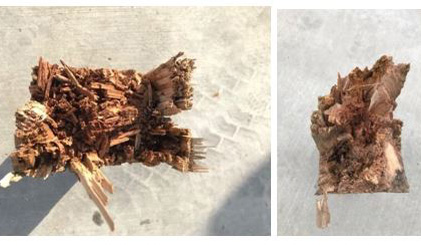This project investigated the integrity of wood guardrail posts in strategic locations of Washington state. WSDOT will be able to use the results to revise wood treatment specifications and/or design guidance for wood guardrail posts.
Guardrail systems protect motorists involved in a crash by dissipating energy and preventing them from leaving the roadway. The guardrail post is an important part of the system. Unfortunately, wood guardrail posts are susceptible to failing because of a loss of strength from wood decay. Wood decay may be caused by fungal growth or insect intrusion and is difficult to detect by visual inspection alone because decay commonly occurs inside the post.
Phase I of this research identified stress wave timing (SWT) as the optimal non-destructive technique for field testing timber guardrail posts. In conjunction with a local industrial firm, Metriguard, Inc., a SWT prototype was built and delivered to the Washington State Department of Transportation (WSDOT).
This Phase II study focused on quantifying the factors that affect wood post service life in the Northwest, including the post’s age, location, and physical properties such as wood species, treatment method, and lumber grade.
This project started with a field investigation of 498 guardrail posts in five regions of Washington state, four along the western coast and one in south central Washington. The field inspections revealed an overall decay rate of approximately 25 percent, but the western regions had most of the decayed posts (up to 37 percent in one region), and the central region had a low decay rate of 5 percent. The 126 decayed posts located during field inspections were removed from service and delivered to Washington State University for additional testing and analysis.
Further analysis investigated factors that could lead to higher rates of decay. Neither post age (about 23 to 28 years) nor wood species grouping could be strongly linked to increased rates of decay. The factor that most strongly predicted high decay rate was climate index, a measure of a region’s average annual rainfall and temperature. Three of the four regions with a climate index of greater than 40 had decay rates near or above 30 percent.
Material and preservative treatment testing conducted at Oregon State University determined that the preservative penetration depth was within the American Wood Protection Association (AWPA) standard of 10 mm for all sample posts. However, preservative retention was lower than the AWPA standard for approximately 70 percent of the sample posts. This means that poor preservative retention may have been a factor in the high decay rates.
Pendulum impact tests were also conducted on 15 posts with varying levels of decay. The tests determined that decay decreased the posts’ impact resistance by more than 50 percent.
The results of the field and laboratory studies demonstrated that SWT is capable of identifying posts with internal decay. Additionally, SWT test results can be useful in considering the role of post decay in an agency’s asset management strategy. The researchers recommended that WSDOT specify the AWPA’s UC4C (extreme duty) treatment category for newly acquired batches of treated timber posts that are intended for areas that have a climate index of greater than 60 because of those areas’ severe service conditions and resulting high decay risk. They also recommended that newly acquired batches of treated timber posts be inspected by an agency accredited by the American Lumber Standard Committee and include the standard quality control mark to ensure that preservative penetration and retention levels meet AWPA-specified minimums for their respective treatment categories.
Authors:
Adam Phillips
Qiyang Luo
WSU Department of Civil and Environmental Engineering
Sponsor: WSDOT
WSDOT Technical Monitor: Brad Manchas and John Donahue
WSDOT Project Monitor: Doug Brodin

